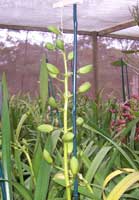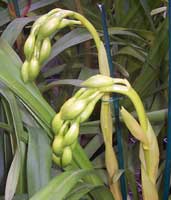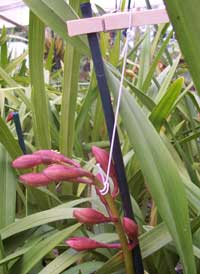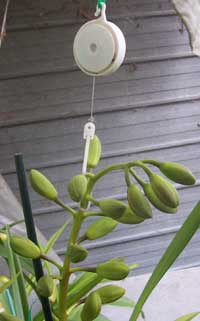| Cymbidiums come in 4 different styles as shown in the pictures below. Growers need to become familiar with their plants so they know the habit of the particular spike and can treat each plants appropriately. The notes below refer mainly to upright spikes. The techniques may be used on decorative and arching style cymbidiums but only on the lower part of the spike. | |||||||||||||||
 |
 |
 |
|||||||||||||
| Upright | Arching | Decorative | Pendulous | ||||||||||||
| This first example shows a Cymbidium which has a new spike showing. It had started off more horizontal than vertical and has had a label put in front of it to help it to grow more vertical.
|
 |
||||||||||||||
| The spike has now progressed
beyond the assistance of a label so a piece of light elastic has been
used. A loop is tied at one end and then slipped over the spike. The
other end is wrapped around the stake several times and is held with a
clothes peg so that there is always some tension between the spike and the
stake. This is then adjusted every few days by tightening the elastic
until the spike is pulled up close enough to be tied to the stake. When tying to the stake higher up the spike where it may still be elongating a figure of eight should be used with the twisty tie so it can be moved up as the spike elongates and is not too tight around the spike. |
 |
||||||||||||||
| Several weeks have passed and the buds are now showing. At this stage the top section will grow straight on some cymbidiums but needs to be encouraged on others. This is achieved with the use of elastic tied in a slip knot around the spike and stretched up to a clothes peg higher up on the stake. Tension is maintained by wrapping the elastic around the peg if necessary and by sliding the peg up the stake every few days. The slip knot is also moved upwards once a week or so as the distance between buds increases. In the picture shown it is time to put a tie on where the elastic is looped and move the loop up 2-3 buds. |
 |
||||||||||||||
| This picture shows the use of a
yoyo to keep the spike upright and help to space the flowers. Yoyos must
be attached somewhere above the orchid to the roof for example and the tension must be adjusted by
looping or unlooping some of the loops from the yoyo. Too much
tension can pull the top off the spike. |
 |
||||||||||||||
| The extreme case. The 3 pictures below show what can be done if the spike is discovered late and has headed off in the wrong direction. The lower part of the spike has also hardened to some extent making it difficult to bend. The same technique as above can be tried to
try to correct the situation. In this case a fibreglass stake has
been used so the stake can be easily turned every few days to wind the
elastic on an extra turn or two. This makes it easier to maintain
the tension and over a period of a month or so the spike has been pulled
up to a satisfactory position. The first picture shows the
spike as found. The lower part of the spike had already started to harden. Note. Great care must be taken in extreme cases as the result can easily be a broken spike. Do not try to pull the spike up too much when attaching the elastic for the first time or when tightening the elastic. The constant tension will slowly have the desired effect in most cases as the spike continues to grow. |
|||||||||||||||
|
|
|
|||||||||||||
| FAQ
How can I tell what style a cymbidium will be and whether or not
to stake it? GO TO index for MORE ORCHID CULTURE INFO |
|||||||||||||||


